The relationship between the monetization of games and the behavior of gamers
Recently, I studied in detail the GameAnalytics report, containing some statistics on the different behavior of gamers. Analyzing, one can understand something essential in these games.
In addition to a large group of non-paying gamers, the players in this report are divided into 3 types: "minnows" (players "by occasion") (minnows (lowcore)), "dolphins" (regular players) (dolphins (midcore)) and "whales" ( gamers fans) (whales (hardcore)).
Non-paying players tend to try, as a rule, more different games than dolphins and whales. “Dolphins” and “whales” are more focused and use a small number of games or even just one game. The definition of a group of players is given in the GameAnalytics report.
')
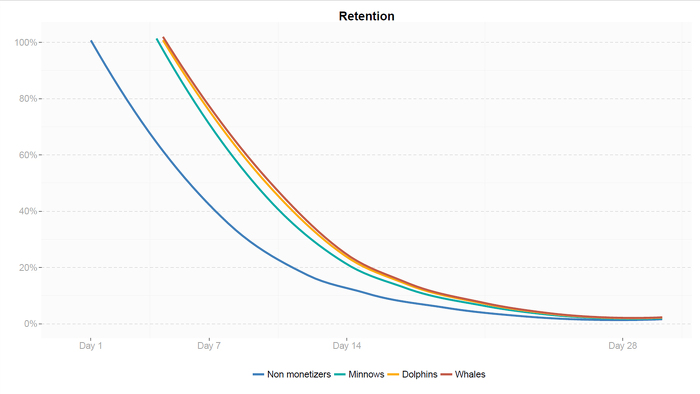
Retention of various players (source: GameAnalytics, 2016)
Obviously, "whales" retain interest in the game longer. Non-paying players show less attachment to the game, but spend more time on it and spend more sessions if they already enter the game.
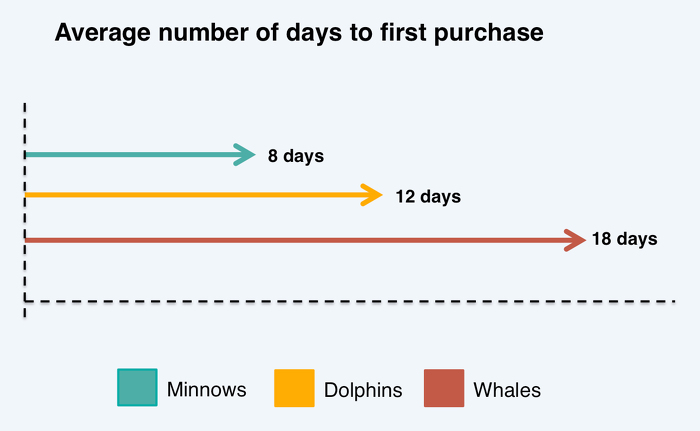
The average number of days to first purchase (source: GameAnalytics, 2016)
It takes up to 18 days for the "whales" to make a decision about payment, while the miners only need 8.
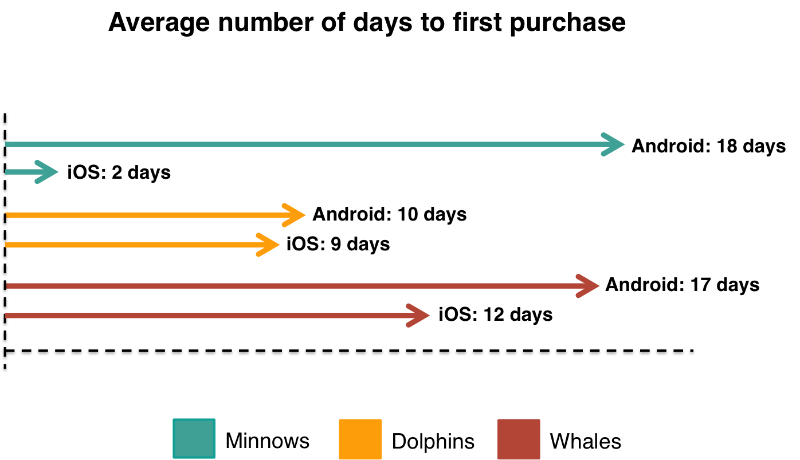
The average number of days before the first purchase on different platforms (source: GameAnalytics, 2016)
When comparing different platforms, you can see that iOS users make decisions faster than Android users.
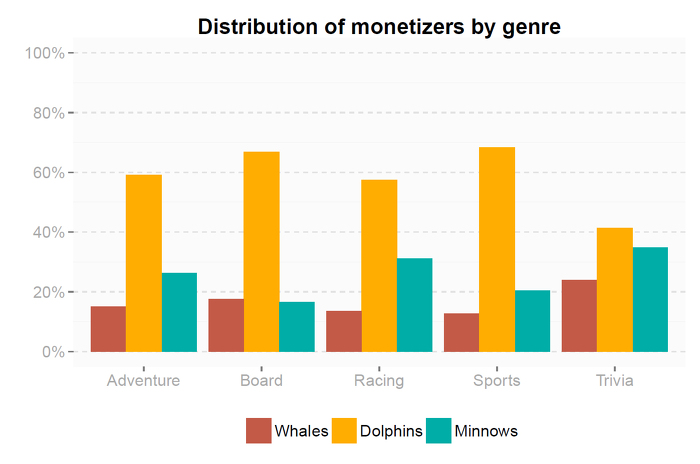
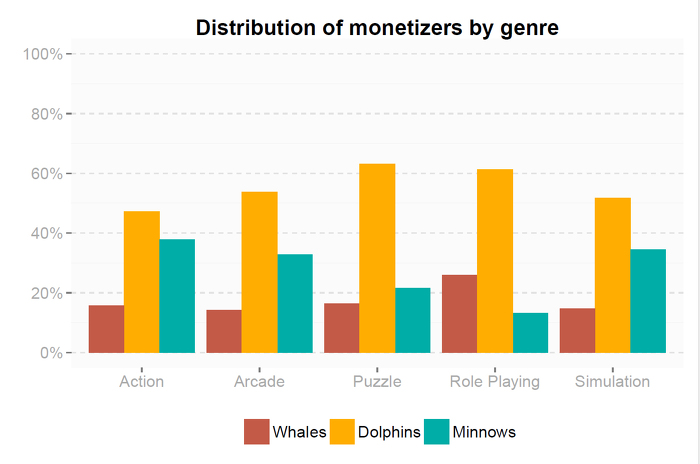
Distribution of paying players by game genres (source: GameAnalytics, 2016)
"Whales" are attracted to role-playing and board games, quizzes, with role-playing being preferred.

The share of each group of players in the total income (source: GameAnalytics, 2016)
“Pescari” make up 50% of the total number of paying players, but they give only 1% of income, whereas 86.6% of the income from games comes from “whales”.

Distribution of groups of players depending on the platform - Android or iOS (source: GameAnalytics, 2016)
The share of reputable payers on the iOS platform is significantly higher than on Android.
More than 60% of Android users are “minnows,” while iOS is dominated by dolphins. "Dolphins" on iOS make up 70%, and "minnows" - only 15%.
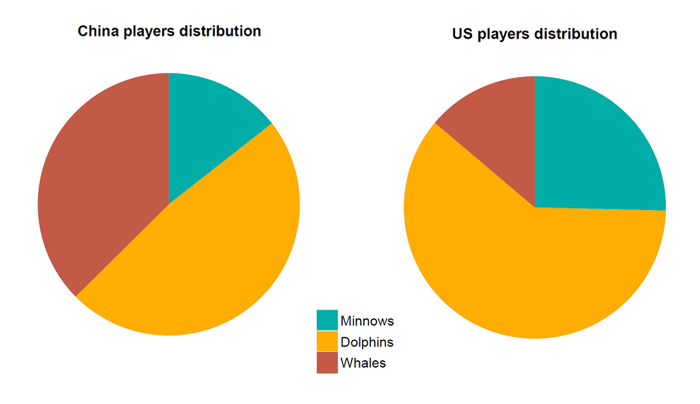
Distribution of gamers in China and the USA (source: GameAnalytics, 2016)
According to the data provided by GameAnalytics, 64% of gamers in the United States are dolphins, 48% in China. However, the share of “whales” in China is much higher than in the United States: 37.37% against 14.42%. Moreover, whales in China spend an average of $ 347.39, and in the United States, $ 283.90.
The GameAnalytics report can be summarized in the following 3 positions:
1. “Dolphins” and “whales” most often remain loyal to a small number of games or even one game.
2. Non-paying gamers tend to use more different games, while whales spend fewer sessions per week.
3. “Whales” usually need more than 10 days from installing the game to purchasing it.
Even if this report does not show something new about the behavior of gamers in the monetization of games, but still, it is interesting to see that these statistics confirm what we intuitively believe is correct.
It is clear that whales are extremely important in the profitability of the game. However, developers should not blindly rely on the high% of "whales" in their game. A good game should provide a balanced combination of paying and non-paying users. The latter are a kind of foundation "whales". Recall that “whales” usually spend less time on the game, while non-paying users refer to those who, indeed, give their lives to the game and support the gaming community. Without a significant number of non-paying users in your game there will be no “whales” at all. This is especially true for massively multiplayer online games.
In addition, many non-paying users provide a good opportunity to monetize the game through advertising embedded in mobile applications. This category of users is usually not annoying in-game advertising. In accordance with the latest report from Unity ( report ), 71% of gamers prefer viewing in-game commercials as a sort of their way to “pay for” a mobile game, which is much higher than the other two main ways of monetization *.
* Three main ways to monetize in applications: in-app purchases (IAP), in-line advertising, and price premium.
» Original GameAnalytics report.
In addition to a large group of non-paying gamers, the players in this report are divided into 3 types: "minnows" (players "by occasion") (minnows (lowcore)), "dolphins" (regular players) (dolphins (midcore)) and "whales" ( gamers fans) (whales (hardcore)).
Non-paying players tend to try, as a rule, more different games than dolphins and whales. “Dolphins” and “whales” are more focused and use a small number of games or even just one game. The definition of a group of players is given in the GameAnalytics report.
')

Retention of various players (source: GameAnalytics, 2016)
Obviously, "whales" retain interest in the game longer. Non-paying players show less attachment to the game, but spend more time on it and spend more sessions if they already enter the game.

The average number of days to first purchase (source: GameAnalytics, 2016)
It takes up to 18 days for the "whales" to make a decision about payment, while the miners only need 8.

The average number of days before the first purchase on different platforms (source: GameAnalytics, 2016)
When comparing different platforms, you can see that iOS users make decisions faster than Android users.


Distribution of paying players by game genres (source: GameAnalytics, 2016)
"Whales" are attracted to role-playing and board games, quizzes, with role-playing being preferred.

The share of each group of players in the total income (source: GameAnalytics, 2016)
“Pescari” make up 50% of the total number of paying players, but they give only 1% of income, whereas 86.6% of the income from games comes from “whales”.

Distribution of groups of players depending on the platform - Android or iOS (source: GameAnalytics, 2016)
The share of reputable payers on the iOS platform is significantly higher than on Android.
More than 60% of Android users are “minnows,” while iOS is dominated by dolphins. "Dolphins" on iOS make up 70%, and "minnows" - only 15%.

Distribution of gamers in China and the USA (source: GameAnalytics, 2016)
According to the data provided by GameAnalytics, 64% of gamers in the United States are dolphins, 48% in China. However, the share of “whales” in China is much higher than in the United States: 37.37% against 14.42%. Moreover, whales in China spend an average of $ 347.39, and in the United States, $ 283.90.
The GameAnalytics report can be summarized in the following 3 positions:
1. “Dolphins” and “whales” most often remain loyal to a small number of games or even one game.
2. Non-paying gamers tend to use more different games, while whales spend fewer sessions per week.
3. “Whales” usually need more than 10 days from installing the game to purchasing it.
Even if this report does not show something new about the behavior of gamers in the monetization of games, but still, it is interesting to see that these statistics confirm what we intuitively believe is correct.
It is clear that whales are extremely important in the profitability of the game. However, developers should not blindly rely on the high% of "whales" in their game. A good game should provide a balanced combination of paying and non-paying users. The latter are a kind of foundation "whales". Recall that “whales” usually spend less time on the game, while non-paying users refer to those who, indeed, give their lives to the game and support the gaming community. Without a significant number of non-paying users in your game there will be no “whales” at all. This is especially true for massively multiplayer online games.
In addition, many non-paying users provide a good opportunity to monetize the game through advertising embedded in mobile applications. This category of users is usually not annoying in-game advertising. In accordance with the latest report from Unity ( report ), 71% of gamers prefer viewing in-game commercials as a sort of their way to “pay for” a mobile game, which is much higher than the other two main ways of monetization *.
* Three main ways to monetize in applications: in-app purchases (IAP), in-line advertising, and price premium.
» Original GameAnalytics report.
Source: https://habr.com/ru/post/307314/
All Articles